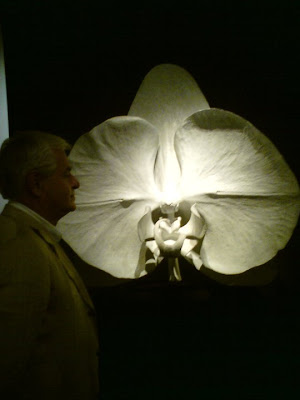On Tuesday night Albert Watson gave an informative lecture at the Victoria & Albert museum to coincide with his exhibition Vintage Watson at Hamilton's Gallery (which opened last night). Watson, born in 1942, is one of the most important photographers of our time, respected for his contribution to the world of fashion, art and music: having shot over 200 covers for Vogue as well as several iconic Rolling Stones' covers. At university he studied graphic design and then went to film school at the Royal Collage of Art. As a result he sees his work as a combination of the two- graphics and cinematography.
Watson is a photographer of diverse subject matter who has captured every angle of life over a period of four decades, producing a prolific portfolio. He lives through his work quite literally and he will continue to live on through it even after his time. Finding the subject, perceiving the subject, the composition and the lighting is what personifies his work and makes it unique to him. When photographing Alfred Hitchcock in 1973 for a poultry recipe the intention was to present the goose on a plate but instead, the young photographer urged Hitchcock to grab the goose by its throat and so created an entirely different image. This was a turning point in his career after which the influx of requests to work with him have not ceased.
 |
| Alfred Hitchcock with Goose, Los Angeles, Christmas, 1973 |
Watson's dedication to his subject is unquestionable and personal: he waited two and a half years to under go the application process which would allow him to photograph the ancient Pharaoh Tutankhamen's artifacts. His interest in history and his attitude towards preservation are here exemplified.
He recognises the 1970s as the starting point of his career, which in retrospect he sees as a frustrated period but one which allowed him to develop his skills and enter the 80s with no technical difficulties or barriers. This gave way to his most creative and achieved period. In the 70s he remembers being frequently 'discontent' with his work and saw three phases in his analytical digestion. Initially he'd posses a youthful arrogance about his images, a few days after his shoot he'd be unsure and then some weeks later he would want to destroy the work. They lacked subtlety. This was not a fierce reaction by any means but Watson would recognise the technical flaws and the sometimes harsh lighting in his work. Neither is this to say he was not enormously successful nor to dismiss his work from the 70s. It is merely a comparison of one period to the other and his feelings towards them.
He speaks with a thick accent, Scottish yet masked with a distinct American overtone. He is very polite, well mannered and charming: a tribute to having worked with so many people and supported by his British education. There is no air about him.
Although he has shot over 600 commercials (a great deal of which were fashion related), Watson claims that he was often criticised by editors for not being fashionable; his photos were not fashionable but rather of fashion. In hindsight, he sees this as a positive feature, contributing to the classicism of his work and the longevity of his appeal.
Albert Watson prints all of his own work (Richard Avedon, for example, does not). He says of the future of photography: it lies in digital but that this does not mean that one should abandon the correct form of learning. It doesn't make one a better photographer just because you can do more,"digital photography makes amatures better". Sometimes, when Watson feels his work looks too polished, he puts down his four by five camera and picks up a 35mm, loosens and resets himself back to his roots.
 |
| Naomi Campbell, Palm Springs, 1989 |
This composition was a work in practice, as Naomi Campbell was being shaded from the sun with a cloth, held behind her, Watson noticed the beauty of her profile and shadow which blocks her face and realised that this was the image he would use.
 |
| Kate Moss, Marrakesh, Morocco, 1993, 1993 |
 |
| Keith Richards, New York, 1988 |
 |
| Gabrielle Reece and Michaela Bercu, Pasadena, California, 1989 |
 |
| Kate Moss, Marrakech, 1993 |
 |
| Mick Jagger, Los Angeles, 1992 |
This image has not been digitally manipulated or retouched; Watson took a photograph of Mick Jagger (in a car with a leopard for a shoot) and then rewound the film back to the image and created a double exposure, photographing the leopard on top.
 |
| Heel Budget Suites, Las Vegas, 2000 |
Rather Bob Carlos Clarke, Watson recalls when he discocovered the meaning of dominatrix in America.
 |
| Mike Tyson, Catskills, New York., 1986 |
His father was a boxer which is why he knew to shoot Mike Tyson from behind, exemplifying the breadth of his neck as a trophy itself and a tribute to his profession.
 |
| The GOD Sign, Route 15, Las Vegas, 2001 |
 |
| Jellyfish Tank Series Mandalay Bay, Las Vegas, 2001 |
Currently, there is an exhibition of Albert Watson's work Vintage Watson at Hamilton









